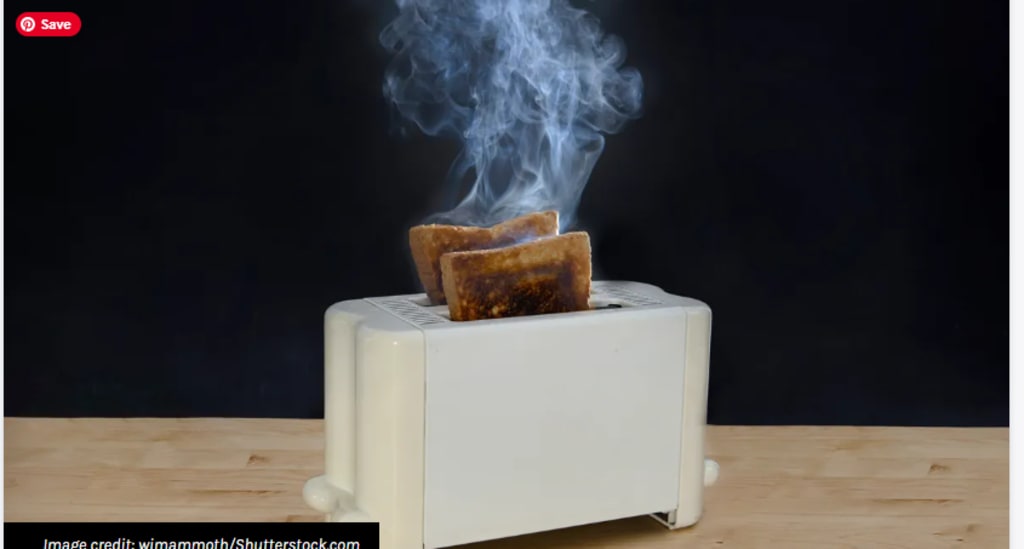The Unknown Risks Associated With Consuming Burned Toast: Essential Information
It is true that it contains a carcinogen, but is that all there is to it?

We salute the person who first saw a piece of bread and said, "Hell, let's cook it again, and see what happens." Toast is fantastic because it can be dipped in eggs, covered in beans, spread with butter and jam, or even used as a stand-alone sandwich.
Best of all, you can enjoy your meal with the satisfaction that it is slightly healthier than the bread it was made from. We use the phrase to refer to "a celebratory speech and drink in honor of something good" for a reason, and that reason is that toast is delicious and fantastic.
But toast that has burned? Revolting. Rank. As enjoyable as biting into a piece of charcoal. It tastes so bad and smells like a stroke that it can actually cause cancer. And science backs up what we're saying. Is it, though?
While making toast, what happens?
Toasting is a kind of chemical reaction, just like any other cooking. In fact, it's a very particular one: it's known as the Maillard reaction, and it only happens at temperatures of about 120°C (248°F).
The basic idea behind the Maillard reaction is this: although it's a fairly intricate process, the reducing sugars in bread are primarily maltose and glucose (with some fructose added in America), but they can also be found in other foods. include lactose or ribose, for example—reacting with the amino acids in the bread to produce a variety of intriguing flavor and aroma molecules in addition to a color shift.
Basically, the flavor of most cooked meals is due to the Maillard reaction. According to Science of Cooking, "hundreds of distinct flavor compounds are created in the process." These substances then combine to create new flavor compounds, and so on. The Maillard reaction creates a unique collection of flavor compounds that are unique to each type of food.
What then is the issue? All of that boils down to those amino acids, specifically asparagine. It can be found in many of your favorite foods, such as bread, potatoes, cereals, and Sadly, researchers in Sweden found back in 2002 that the Maillard reaction uses asparagine to create acrylamide, a nasty little chemical. This makes cookies and coffee unappealing.
Acrylamide: what is it?
Unbelievably, for an organic compound that is created when we brown toast, acrylamide is actually white. It's classified as a "confirmed carcinogen" by the NIH National Library of Medicine and as "very toxic" by CAMEO Chemicals.
When it's not adding flavor to our roasties, it's used in adhesives, dyes, and sewage and waste treatment. If that isn't enough, it can blow up when exposed to excessive heat or sunlight.
In spite of everything, discovering it in your food shouldn't make you angry. According to a factsheet on the substance published by the European Food Safety Authority (EFSA), "it is likely that acrylamide has been present in food since cooking began." It is nearly hard to completely cut out acrylamide from a diet.
Sadly, acrylamide is not very good for us, to put it mildly. It is well known to be neurotoxic, which means that it alters our nervous system. Consuming it over an extended period of time may raise your chance of developing neurodegenerative illnesses like dementia.
It may even interfere with a fetus's development: Acrylamide is soluble in water and has a low molecular weight, which allows it to pass through all tissues, including the placenta. Federica Laguzzi is an assistant professor of nutritional epidemiology and cardiovascular medicine.
The risks of cancer are another. High acrylamide levels have been proven to cause cancer in animals, and epidemiological research suggests that this may also apply to humans. The compound has been connected to increased risks of kidney, endometrial, ovarian, and breast cancers, in addition to cancer in general.
But does that genuinely imply eating acrylamide poses a risk? We know this may sound absurd after all that, but bear with us.
Will eating toast cause me to get cancer?
Measuring the risk of cancer in humans has significant issues.
Senior investigator Rashmi Sinha of the National Cancer Institute told Inverse that clinical trials are necessary "to really be able to be to say that this causes cancer." "However, clinical trials involving potentially carcinogenic substances are not permitted."
Acrylamide does indeed cause cancer, according to lab studies; however, the FDA factsheet on the substance states that "the levels... used in these studies were much greater than those found in human food" and that the tests were conducted on mice and rats.
However, humans are just not able to obtain that kind of information.
Rather, by relying on self-reporting over an extended period of time, "the main studies have been association [or] prospective studies," as Sinha clarified. "We follow up with [healthy participants] for ten, fifteen, or twenty years after we ask questions about how they cook their food," explained Sinha.
"Thereafter, we compare individuals with and without cancer to see if there is a relationship between the two groups' food preparation methods."
The issue here is that, in addition to being dishonest and cunning liars, people also have terrible memory recall skills, so whatever information researchers obtain is probably skewed to some extent.
According to BBC Future, Fatima Saleh, an associate professor of medical laboratory sciences at Beirut Arab University in Lebanon, indicates that "there is still inconsistent evidence of its definite carcinogenicity in humans, even after almost 30 years of its classification as a 'probable human carcinogen.'"
"But if we carry out more research on people, we might have enough information to reclassify acrylamide as a human carcinogen," she continued.
Look, should I give up toast or not?
Yes, the crucial query: is toast still acceptable? Actually, you're probably good unless you usually burn it to a crisp before applying your peanut butter on top of it.
Because of campaigns supported by both governments and private businesses, the level you're exposed to is probably lower than it would have been, say, 20 years ago. In addition, our bodies may already have defenses against the compound, according to Laguzzi.
She added, "We don't just eat acrylamide on its own." "It's found in food, where other ingredients like antioxidants may also help prevent the harmful mechanisms."
Furthermore, there are a few fairly easy methods you can use to lower the amount of acrylamide in your cooking. For example, soaking potatoes in hot water for 10 minutes reduces the formation of acrylamide by nearly 90%.
The answer is equally simple for toast: just don't burn it. "Some countries advise consumers to brown food lightly instead of burning it, as acrylamide levels are directly linked to this process," the EFSA notes. Other nations have taken it a step further.
The Food Standards Agency in the UK, for example, started a campaign in 2017 encouraging people to "Go for Gold" when making toast, which highlights the significance of burned bread in the island nation.






Comments
There are no comments for this story
Be the first to respond and start the conversation.